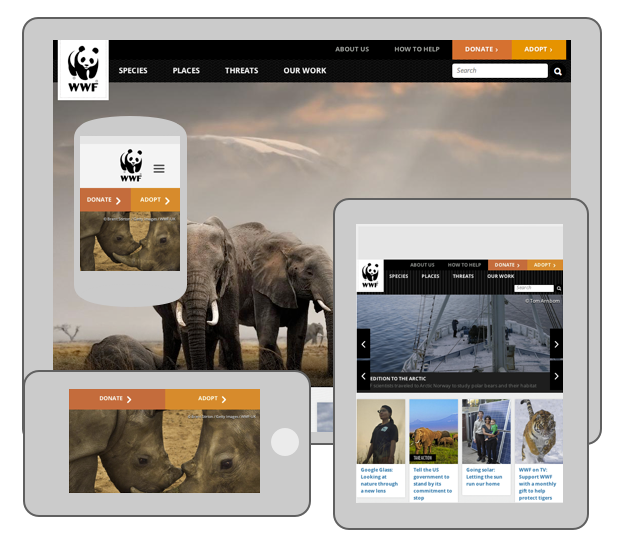Friday I spoke at “The Digital Nonprofit,” the 4th annual NetSquared conference. It was a chance for mid-level marketers, fundraisers, event planners and administrators to bring their executive, senior staff or board members to talk about creating an impact with technology within their charities and nonprofits. Below are some of the highlights from the speakers on communication strategy, executing campaigns and effectively engaging stakeholders.
Monique Sherrett of Boxcar Marketing opened the day with “Communication Strategies for the Multi-Screen World”

Takeaways
- Technology changes (and quickly). This has an impact on your organization and its communication strategy because it changes how people want to interact with each other and with organizations.
- As the tools change (desktop, laptop, tablet, mobile, wearables), the display, format and experience changes. Design for the experience, not for the device.
- Start with a responsive website so you focus on content that is displayed optimally for the device. The practical benefits are that you have a single site to maintain and a single set of URLs to share and index.
- Motto is 1 eye, 1 thumb, 1 arm. Text and visual cues are easy to scan (1 eye) and view at a distance (1 arm's length). Targets are big enough to click with certainty (1 thumb).
- Always focus on owned channels (website, email lists) vs. leased channels (social media).
- Email is key. Re-examine the subscribe process from a mobile perspective. Simplify forms, ensure sign-up works.
- Use responsive email templates: 50% of emails are opened on a mobile device.
- Leverage opportunities presented by the device, i.e., the pre-header text area that shows a snippet of the email content
- Leverage opportunities presented by the channel, i.e., hashtags for #FundraisingFriday and #ThrowBackThursday can be used to highlight campaigns present and past
- Make a plan. See the penultimate slide on what to do when.
Lynda Gerty of Vantage Point – “The Abundant Not-for-Profit: linking engagement and technology”
Takeaways
- Everyone in the organization needs to be involved in proactively engaging people with the organization and its causes.
- There are ways, aside from money, to engage people.
- If you open up otherwise closed processes (annual reports, board meetings, financials, filing systems), you open up opportunities for people with skills to help your organization in ways that are rewarding for both parties. For example, a marketing strategist can offer communications ideas, an investment banker can suggest ways to fundraise, a librarian can help create a digital file system.
- Time Raisers holds meet-ups to help raise volunteer time vs. money for organizations.
John Bromley of Chimp.net – “What Does Charity Look Like in 2020?”
Takeaways
- In the future ther will be a major social network for charity. It will be controlled by the people, for the charities.
- Today's fundraising won't work in the future.
- Donors might not be giving away their own money. Instead it may be brokers who are responsible for deciding on giving portfolios, or influencers who determine what charities get funds. Right now individuals give to charities, but in the future it may be that individuals give to a broker or third party who decides and manages.
- Online donations are not all small monetary gifts. Money is not the biggest thing that gets donated. Other examples would be land, public securities.
- There will continue to be fragmentation. More charities, more nonprofits, more causes to support, more choice about who to give to and when, more platforms that facilitate giving.
- Nonprofits and charities are not the same. Charities issue tax receipts, nonprofits do not. There is a database of all registered charities.
- Businesses care about people. People care about charities. This is why businesses give away money. There needs to be an ROI, which could be measured through employee retention or because of the value the association brings to the brand.
- Individuals will have charity accounts, like Chimp, that are used to save for donations. (I think of it as the PayPal of charitable giving.)
Meriko Kubota of Telus Public Affairs – “Corporate Community Investment: How Technology is Improving Social Impact”
Takeaways
- Community investment is seen internally at corporations as a cost centre.
- The ROI of giving might be things like the likelihood a person is to recommend the brand or that they are influenced in their buying decision by the company's social works.
- Pay attention to where community managers sit within an organization. It's usually the PR or marketing department. This is indicative of the intention/expected return on those activities. Community Investment is in the HR department at Telus because community is important to employee retention and satisfaction.
- Telus gives more than their closest competitors combined (Bell, Rogers, Shaw)
The afternoon speakers included:
- Crystal Henrickson of Invoke Labs – “Social Media Strategy for Nonprofits”
- Reilly Yeo and Vojtech Sedlak of OpenMedia.ca – “The Engagement Pyramid: Keeping supporters engaged for the long haul”
- Lee Lefever of Seattle’s Common Craft – “The Art of Explanation”
Presenter slides will be made available. In the meantime, here are the slides on marketing in a multi-screen world.


